Korean mixed script
| Korean mixed script 한국어의 국한문혼용 韓國語의 國漢文混用 | |
|---|---|
 | |
| Type | |
| Languages | Korean language |
Time period | 1443 to the present |
| Direction | Left-to-right |
| ISO 15924 |
Kore, 287 |
| Korean mixed script | |
| Hangul | 한자 혼용 / 국한문 혼용 |
|---|---|
| Hanja | 漢字混用 / 國漢文混用 |
| Revised Romanization | Hanja honyong / Gukhanmun honyong |
| McCune–Reischauer | Hancha honyong / Kukhanmun honyong |
.jpg) |
| Korean writing systems |
|---|
| Hangul/Chosŏn'gŭl |
| Hanja |
| Mixed script |
| Braille |
| Transcription |
| Transliteration |
Korean mixed script, known in Korean as hanja honyong (漢字混用, 한자 혼용), 'Chinese character mixed usage,' or gukhanmun honyong (國漢文混用, 국한문 혼용), 'national Sino-Korean mixed usage,' is a form of writing the Korean language that uses a mixture of the Korean alphabet or hangul (한글) and hanja (漢字, 한자), the Korean name for Chinese characters. The distribution on how to write words usually follows that all native Korean words, including grammatical endings, particles and honorific markers are generally written in hangul and never in hanja. Sino-Korean vocabulary or hanja-eo (漢字語, 한자어), either words borrowed from Chinese or created from Sino-Korean roots, were generally always written in hanja although very rare or complex characters were often substituted with hangul. Although the Korean alphabet was introduced and taught to people beginning in 1446, most literature until the early twentieth century was written in literary Chinese known as hanmun (漢文, 한문).
Although examples of mixed-script writing are as old as hangul itself, the mixing of hangul and hanja together in sentences became the official writing system of the Korean language at the end of the nineteenth century, when reforms ended the primacy of literary Chinese in literature, science and government. This style of writing, in competition with hangul-only writing, continued as the formal written version of Korean for most of the twentieth century. The script slowly gave way to hangul-only usage in North Korea by 1948, but it continues in South Korea to a limited extent, but with the decrease in hanja education, the number of hanja in use has slowly dwindled that in the twenty-first century, very few hanja are used at all.[1]
History
Adoption of Hanja
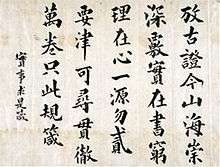
The adoption of hanja in Korea began gradually. The earliest users were likely Han Chinese immigrants that settled the commanderies established during the Chinese Han Dynasty between 108 BC-313 AD, but most of the Chinese were absorbed and assimilated into the Korean population. The earliest evidence of hanja are the engravings on a sword uncovered in Pyeongyang from 222 BC, but the earliest extensive example of its usage is carved stone inscription from 85 AD in what is now South Pyeong-an Province, North Korea. The scholars of the Kingdom of Baekje were so well-versed in reading and writing literary Chinese, many found employment as teachers in what is now Japan, thus spreading Chinese culture and writing in Chinese characters there as well. Religion helped play a major role in the adoption of literary Chinese. Chinese missionaries spread Buddhism into Korea, and as Korea slowly became a Buddhist country, Korean monks were often sent to China to study, some solely to copy Chinese works. Buddhism was suppressed under most of the Joseon Dynasty, which resurrected State Confucianism and the promotion of the Analects, as well as the commentary of Neo-Confucian scholars, as required literature.[2]
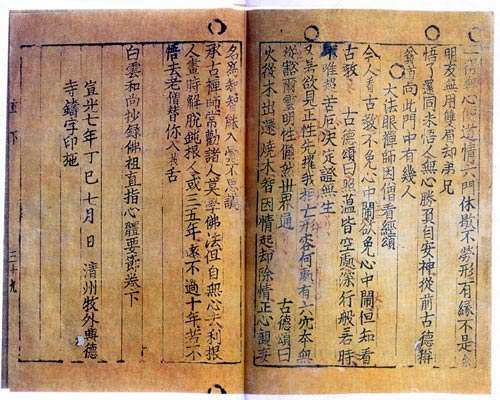
Most reading and writing was conducted in literary Chinese, with its grammatical features such as SVO, analytic structure and generally terse structure as opposed to spoken Korean, with generally SOV, highly synthetic verb structure and various suffixes and infixes used to mark levels of politeness and other grammatical features unknown in Chinese.[2] By the Goryeo period of early tenth century AD, Korean literati created several methods to either make Chinese readable to Koreans or to render Korean fully using the available hanja. In the gugyeol (口訣, 구결) system, Chinese texts were separated into meaningful blocks, with a special subset of characters used to represent the sounds of Korean grammatical endings or to indicate the 'Korean' ordering of how to read the characters to approximate Korean grammar.[3]
In the idu (吏讀, 이두) system, hanja were used to write Korean by using their associated native Korean gloss (or pronunciation), its Sino-Korean pronunciation or was used for its meaning. A small subset of characters were used to write the Korean grammatical suffixes and particles. Poetry was often composed in a simpler system known as hyangchal (鄕札, 향찰) where characters were only used for their pronunciation, but knowledge of hyangchal required thorough knowledge of literary Chinese and Sino-Korean readings of characters. In Japan, kanbun corresponds roughly to Korean gugyeol whereas Japanese man'yogana corresponds to Korean hyangchal and idu systems.[3]
Even with the adoption of hangul in 1446 and its subsequent spread, the majority of Korean literature was written in literary Chinese. The yangban (兩班, 양반), upper classes were trained in reading and writing from an early age to pass the 'gwageo (科擧, 과거) or 'Imperial examination,' which like its Chinese original, required extensive knowledge of the works of Confucius, other Chinese scholars, calligraphy and ability to read, write and interpret literary Chinese. Literary Chinese continued to serve as the language of royal records, governance, literature and historic annals, allowing for easy correspondence with China, Japan and Vietnam, which all used the same writing system, until the early years of the twentieth century.[3]
Promulgation of Hunminjeong-eum
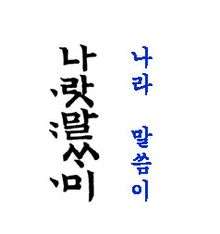
In 1446, King Sejong the Great (朝鮮 世宗大王, 조선 세종대왕) introduced hunminjeong-eum (訓民正音, 훈민정음), 'correct pronunciation for teaching the people' in a proclamation, published with extensive description of the new alphabet. Sejong begins the document (in literary Chinese), 'Because our language is different from the Chinese language, our poor people cannot express themselves in Chinese writing. In my pity for them I create twenty-eight letters, which all can learn easily and use in their daily lives.' This script is now known as hangul in South Korea and choseongul in North Korea, with the proclamation celebrated as national holidays on the 9th of October in the south and the 15th of January in the north, respectively.[4][5]

The new script spread rapidly among the segments of society that were traditionally denied access to education, such as women (except those in the higher classes), farmers, fishermen, rural merchants and children. Despite later attempts to ban the Korean alphabet, as commoners wrote disparaging this about rulers they disliked, and the fear that the upper classes would lose the privileges of being literate in Chinese led to attempts to ban the alphabet, but hangul survived. The twenty-eight letters, arranged into syllable blocks, actually facilitated the study of hanja as they were used in teaching guides to indicate the native word and the Sino-Korean pronunciation, and the upper class, despite their disdain, would often have to study the gugyeol system of knowing a Chinese character's meaning, Sino-Korean pronunciation and its native Korean equivalent, and hangul thus became an important tool in teaching hanja. Nevertheless, its use as an exclusive writing system was mocked by the upper classess as jinseo (真書, 진서) or 'real script.'[5]
The Korean alphabet spread despite attempts to reverse its use. The popularity of the new script really took off with the growth of vernacular poetry in the late eighteenth century. The popular sijo poetry style, a Korean format influenced by the poetry of Tang Dynasty China, was traditionally composed in literary Chinese, but many composers in this period began to adapt the style to Korean written exclusively in hangul and thus, reachable to the masses. Similarly, the popular gasa essays, popular with yangban women that often turned them into songs, were also generally composed exclusively in Korean and written in hangul. Christian missionaries used hangul exclusively in their missions, with Christians now in the majority in South Korea. The spread of Christian publications and vernacular poetry and songs truly ushered a rebirth in poetry and common forms of expression. Nevertheless, the spread of hangul was by no means the end of hanja, which enjoyed its privileged use as the language of international relations, literature, history, royal annals, governance and law written in literary Chinese.[5]
The letters were devised by Sejong and a number of scholars, with the shapes somewhat based on the shape of the mouth needed to pronounce them as well as traditional aesthetic principles of balance, vowel harmony and sacred geometry. The letters were easy to learn and were written in syllable blocks. Although many of the older hangul novels and works contained passages and notes in literary Chinese and mixed script, by the eighteenth century, the use of hangul to write vernacular Korean versions of gasa (歌詞, 가사) and sijo (時調, 시조) poetry was adopted by commoners and really pushed hangul as a more commonplace writing system.[6]
Mixed script
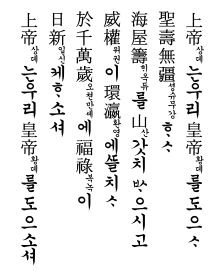
The Korean kingdoms had traditionally become client states of China under nominal tributary status. As western colonial and trade expansion into Asia occurred, it exposed the weakness of China due to centuries of isolation, and led Japan to modernize and nurture its own colonial designs, but many of the skirmishes occurred in Korea, and ultimately, was a battle over political and cultural control of Korea. The clear waning of Chinese protection and the looming threat of Japanese occupation led to numerous uprisings such as the Donghak Peasant Rebellion (東學農民革命, 동학 농민 혁명). In response, King Gojong instituted a series of proclamations, the Gap-o Reforms (甲午, 갑오) of 1894-1896. This led to the termination of the client relationship with China when King Gojong proclaimed himself Emperor Gwangmu (高宗光武帝, 고종 광무제). Emperor Gwangmu also ended the gwageo examination system and the use of literary Chinese as the language of the royal court, courts, government records and sanctioned literature. Korean written in the 'national letters' (國文, 국문)—now understood as an alternate name for hangul—but actually referred to the mixed script was made the official language of governance.[7]
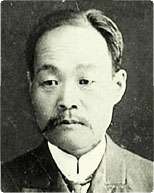
Initially, the mixed-script publications used hangul very sparingly, and were written in a stiff, prosaic format with an over-abundance of Sino-Korean vocabulary. Within a few years, the script began to change to reflect its formal spoken form, allowing for more common use of native terms and complete writing of the grammatical markers, interjections, exclamations and onomatopoeia in hangul. Despite the promotion of the mixed script at the end of the Joseon Dynasty, examples of Korean mixed-script writing date back to the time King Sejong's proclamation of hangul, which was written completely in literary Chinese, with a few idu passages and mixed-script passages that help 'ease' the reader into the new alphabet. The first novel in hangul, Yongbieocheonga (龍飛御天歌, 용비어천가) or Songs of the Dragons Flying to Heaven, commissioned by Sejong shortly after the proclamation of the Korean alphabet. Yi Yulgok (李栗谷, 이율곡), a Korean scholar and mathematician translated the Analects of Confucius (論語, 논어) in 1590 into Korea, recording the Korean translation in mixed script. Although hailed as a major literary masterpiece of hangul, the translation and works of other Neo-Confucian scholars written in this way were actually in mixed script.[8]
The Hanseong Jugan (漢城週刊, 한성주간), a weekly newspaper in Seoul, began printing in 1886, several years before the reforms, but was in a fairly modern system of mixed script usage. The newspaper was a legacy of a hanja-only newspaper started three years earlier but only lasted three weeks. Other publications began to imitate the Hanseong Jugan. Just around the time of the reforms, one of the first novels printed in Korean mixed script was the travel diary of Yi Giljun (兪吉濬, 유길준) known as Seoyu Gyeonmun (西遊見聞, 서유견문) or 'Observations on Travels in the West.' As educational reforms gave more people access to education and the popularity of Seoyu Gyeonmun and the growth of newspapers such as Hanseong Jugan, use of the mixed script expanded knowledge of hanja to the middle and lower classes. As the literati switched from literary Chinese, more works became available in mixed-script Korean.[9]
| Chinese original | 有朋自遠方來 不亦樂乎 |
|---|---|
| 1590 translation by Yi Yulgok | 朋이 遠方으로브터 오리이시면 樂흡디 아니랴 |
| Hangul-only transcription of 1590 translation | 붕이 원방으로브터 오리이시면 낙흡디 아니랴 |
| Modern Korean gloss | 벗(동문-혹은 뜻을 같이 하는 이)이 있어
멀리서부터 사방에서 오니 혹은 먼 곳에서 오니 또한 즐겁지 아니한가? |
| English translation | 'Having oneself friends arriving from distant regions, is that not happiness?' |
Visual processing
In Korean mixed-script writing, especially in formal and academic contexts, the majority of semantic or 'content' words are generally written in hanja whereas most syntax or 'function' is conveyed with grammatical endings, particles and honorifics written in hangul. Japanese, which continues to use a heavily Chinese character-laden orthography, is read in the same way. The Chinese characters, have different angled strokes and oftentimes more strokes than a typical syllable block of hangul letters, and definitely more so than Japanese kana, enabling readers of both respective languages to process content information very quickly.[10]
Korean readers, however, have a few more handicaps than Japanese readers. For instance, although academic, legal, scientific, history and literature have a higher proportion of Sino-Korean vocabulary, Korean has more indigenous vocabulary used for semantic information, so older Korean readers often scan the hanja first and then piece together by reading the hangul content words to piece the meaning.[10] Japanese avoids this problem by writing most content words with their Sino-Japanese equivalent of kanji, whereas reading Sino-Korean vocabulary according to their native Korean pronunciation or translation was banned in previous reforms, so only a Sino-Korean word can be written in hanja. The handicaps are avoided by the adoption of spaces inserted between phrases in modern Korean, limiting phrases, generally, to a content word and a grammatical particles, allowing readers to spot the native Korean content words faster.
In reading texts, Koreans are faster at reading out passages written in hangul than in mixed script. However, although 'reading' is faster, understanding the texts is facilitated with the use of hanja in higher order language to the large number of homophones in the language, such as the continued role of 'hanja disambiguation' even in hangul-only texts. For instance, daehan (대한), usually understood in the context of the 'Great Han' (大韓, 대한) or 'Great Korean people,' can also indicate (大寒,대한) 'big winter,' the coldest part at the end of January and beginning of February, (大韓, 대한), (大旱, 대한) 'severe drought,' (大漢, 대한) 'Great Chinese people,' (大恨, 대한) 'deep resentment,' (對韓, 대한) 'anti-Korean,' (對漢, 대한), 'anti-Chinese,' or native Korean (대한) 'about or 'toward.'[11] Readers of technical and academic texts often have to clarify terms for the listener to avoid ambiguity, and most hanja are only used when necessary to clear confusion. As can be seen in the example below, the hanja in an otherwise mostly native vocabulary song stand out from the hangul text, thus appearing almost like bolded and enlarged text. This was further amplified in older texts, when hangul blocks were sometimes written smaller than the surrounding hanja.[10]
| First and Third Refrain from Seoul version of the Korean epic song Arirang (아리랑) | |||||||||
|---|---|---|---|---|---|---|---|---|---|
| First Refrain | Mixed script | 나를 | 버리고 | 가시는 | 임은 | 十里도 | 못가서 | 발病난다 | |
| Hangul only | 나를 | 버리고 | 가시는 | 임은 | 십리도 | 못가서 | 발병난다 | ||
| English | 'I-[object]' | 'to abandon-[serial sentence connector]' | 'to go'-[topic] | 'you-[topic]' | 'ten li (distance)-[additive]' | 'to be able to go-[primary conjunctive]' | 'to have sore feet-[conjunctive/gerund]' | ||
| Translation | My love, you are leaving me. Your feet will be SORE before you go TEN LI. 'You are going to abandon me and will not be able to go ten li [before] having sore feet.' | ||||||||
| Third Refrain | Mixed script | 저기 | 저 | 山이 | 白頭山이라지 | 冬至 | 섣달에도 | 꽃만 | 핀다 |
| Hangul only | 저기 | 저 | 산이 | 백두산이라지 | 동지 | 섣달에도 | 꽃만 | 핀다 | |
| English | 'that-[nominal clause]' | 'that' | 'mountain-[nominative]' | 'Baekdu Mountain-[plain declarative]-[nominative]-[casual declarative]' | 'winter solstice' | 'twelfth month-despite-[additive]' | 'to bloom' | 'to blossom' | |
| Translation | There, over there, that MOUNTAIN is BAEKDU MOUNTAIN, where, even in the middle of WINTER DAYS, flowers bloom. 'That one, that is Baekdu Mountain, surely. Despite the [middle of] winter [around the time of the] winter solstice, flowers bloom.' | ||||||||
Hanja disambiguation
The Sino-Korean pronunciation of hanja shares many features in common with modern Cantonese, reflecting the very conservative, and ancient age, of borrowing of many Sino-Korean terms, although the pronunciations of many Sino-Korean words have been somewhat altered by general phonological changes in the language over time. Tone did not survive the brief development in the Middle Korean language period, but Middle Chinese, whence come the earliest borrowings, had already developed tones, and as a result, words distinguished by tone are homophones in modern Korean.[12]
Korean word are often polysyllabic and agglutinating, in direct contrast to the rather terse, one- or two-syllable words with rather limited phonology and no distinguishing tone. Although reading aloud of texts is hampered by hanja, the ability to understand texts to the reader is heavily enhanced by it. Especially in formal written language, such as newspapers, hanja are used to disambiguate the meaning. Reading technical texts so that a listener comprehends fully requires careful, parenthetical descriptions of terms whereas an adept reader of hanja would have no question the meaning when reading a script. This is essentially the main function of hanja in newspapers and other documents after the 1990s when even conservative newspapers switched to generally all-hangul format.[13]
In this article from The Chosun Ilbo (朝鮮日報, 조선일보, Joseon Ilbo) two phrases are disambiguated with hanja: '정점은 2003~04시즌 무패(無敗) 리그 우승이라는 위업을 이룬 것이었다. 아직도 당시의 무패 우승은 회자(膾炙)되고 있다,' 'The pinnacle years of 2003-2004 was a winning victory for the undefeated league. The undefeated championship of that period of time is still praised.'[14] In this case '무패', mupae, is disambiguated by '(無敗)' to indicate it means 'undefeated' and not '無貝' (무패), 'without money.' In the second sentence, '회자,' hoeja, is indicated with '(膾炙)' and means 'roasted meat' but is short for the literary Sino-Korean expression (膾炙人口, 회자인구) which is 'roast meat people's mouths,' and roughly means 'delicious meat is always praised by people's mouths' and can mean 'to praise' or 'to discuss fondly.' Not to be confused with hoeja (灰紫, 회자), which refers to a greyish-purple.[15]
Context can often facilitate the meaning of many terms. Many Sino-Korean terms that are rare and only encountered in ancient texts in literary Chinese are almost unknown and would not even be part of the hanja taught in education, limiting the number of likely choices.[13]
| Sino-Korean (漢字語, 한자어, hanja-eo) homophones | ||||
|---|---|---|---|---|
| 신지 sinji |
종고 jogong |
선공 san-gong |
가기 gagi |
국 gok |
| 信地 patrol zone |
仙種 types of ghost |
先攻 first strike |
佳期 good season nuptial consummation |
局 bureau administration |
| 宸旨 minister |
宗高 noble ancestry |
扇工 fan operator |
可期 expectation to pledge |
國 country kingdom |
| 信之 truthfulness |
終古 ancient times |
船工 shipmate |
佳氣 noble aura |
菊 chrysanthemum |
| 愼之 caution fearfulness |
從姑 paternal cousin |
善恐 throat disease |
家妓 housemaid |
鞠 to bow |
| 臣指 official court minister |
從古 previous times |
善功 virtuous success |
家忌 death anniversary |
鵴 cuckoo |
| 新地 reclaimed land |
鐘鼓 bell and drum |
哥器 Ge ware |
椈 cypress | |
| 新枝 spring growth new branches |
稼器 farm implements |
踘 hackey-sack | ||
| 新知 new knowledge |
麯 malt | |||
| 神地 tutelary deity |
攫 grasp | |||
Example
The text below is the preamble to the constitution of the Republic of Korea. The first text is written in Hangul; the second is its mixed script version.
유구한 역사와 전통에 빛나는 우리 대한 국민은 3·1 운동으로 건립된 대한민국 임시 정부의 법통과 불의에 항거한 4·19 민주 이념을 계승하고, 조국의 민주 개혁과 평화적 통일의 사명에 입각하여 정의·인도와 동포애로써 민족의 단결을 공고히 하고, 모든 사회적 폐습과 불의를 타파하며, 자율과 조화를 바탕으로 자유 민주적 기본 질서를 더욱 확고히 하여 정치·경제·사회·문화의 모든 영역에 있어서 각인의 기회를 균등히 하고, 능력을 최고도로 발휘하게 하며, 자유와 권리에 따르는 책임과 의무를 완수하게 하여, 안으로는 국민 생활의 균등한 향상을 기하고 밖으로는 항구적인 세계 평화와 인류 공영에 이바지함으로써 우리들과 우리들의 자손의 안전과 자유와 행복을 영원히 확보할 것을 다짐하면서 1948년 7월 12일에 제정되고 8차에 걸쳐 개정된 헌법을 이제 국회의 의결을 거쳐 국민 투표에 의하여 개정한다.
1987년 10월 29일
悠久한 歷史와 傳統에 빛나는 우리 大韓國民은 3·1 運動으로 建立된 大韓民國臨時政府의 法統과 不義에 抗拒한 4·19 民主理念을 繼承하고, 祖國의 民主改革과 平和的統一의 使命에 立脚하여 正義·人道와 同胞愛로써 民族의 團結을 鞏固히 하고, 모든 社會的弊習과 不義를 打破하며, 自律과 調和를 바탕으로 自由民主的基本秩序를 더욱 確固히 하여 政治·經濟·社會·文化의 모든 領域에 있어서 各人의 機會를 均等히 하고, 能力을 最高度로 發揮하게 하며, 自由와 權利에 따르는 責任과 義務를 完遂하게 하여, 안으로는 國民生活의 均等한 向上을 基하고 밖으로는 恒久的인 世界平和와 人類共榮에 이바지함으로써 우리들과 우리들의 子孫의 安全과 自由와 幸福을 永遠히 確保할 것을 다짐하면서 1948年 7月 12日에 制定되고 8次에 걸쳐 改正된 憲法을 이제 國會의 議決을 거쳐 國民投票에 依하여 改正한다.
1987年 10月 29日
- Gallery
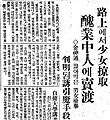 A newspaper on 30 June 1933.
A newspaper on 30 June 1933..jpg) A newspaper on 14 August 1945.
A newspaper on 14 August 1945. Operation Moolah propaganda leaflet by the US Army during the Korean War promising a $100,000 reward to the first North Korean pilot to deliver a Soviet MiG-15 to UN forces.
Operation Moolah propaganda leaflet by the US Army during the Korean War promising a $100,000 reward to the first North Korean pilot to deliver a Soviet MiG-15 to UN forces.
See also
References
- ↑ Song, J. (2015). 'Language Policies in North and South Korea' in The Handbook of Korean Linguistics. Brown, L. & Yuen, J. (eds.) (pp. 477-492). Chichester, UK: John Wiley & Sons.
- 1 2 Taylor, I. & Taylor, M. M. (2014). Writing and Literacy in Chinese, Korean and Japanese: Revised Edition. (pp. 172-174.) Philadelphia, PA: John Benjamins North America.
- 1 2 3 Nam, P. (1994). 'On the Relations between Hyangchal and Kwukyel' in The Theoretical Issues in Korean Linguistics. Kim-Renaud, Y. (ed.) (pp. 419-424.) Stanford, CA: Leland Stanford University Press.
- ↑ Lee, I. & Ramsey, S. R. (2003). The Korean Language. (pp. 39-34.) Albany, NY: State University of New York Press.
- 1 2 3 Taylor, I. & Taylor, M. M. (1994). pp. 180-182.
- ↑ Kim, K. (1996). pp. 76-81.
- ↑ Kim, K. (1996). An Introduction to Classical Korean Literature: From Hyangga to P'ansori. (pp. 211-217). New York, NY: M. E. Sharpe.
- ↑ Ralston, M. K. (2001). Ideas of Self-cultivation of in Korean Neo-Confucianism. University of British Columbia. Phd. Thesis. pp. 38-50.
- ↑ Taylor, I. & Taylor, M. M. (1994). pp. 268-270.
- 1 2 3 Insup, T. (1980). 'The Korean writing system: An alphabet? A syllabary? A logography?' (p. 74-75). New York, NY: Plenum Press.
- ↑ 대한. Naver Hanja Dictionary (in Korean). Retrieved 2018-02-19.L.
- ↑ Patrick Chun Kau Chu. (2008). Onset, Rhyme and Coda Corresponding Rules of the Sino-Korean Characters between Cantonese and Korean. Paper presented at the 5th Postgraduate Research Forum on Linguistics (PRFL), Hong Kong, China, March 15–16.
- 1 2 Taylor, I. (1997). 'Psycholinguistic Reasons for Keeping Chinese Characters in Japanese and Korean' in Cognitive Processing of Chinese and Related Asian Languages. Chen, H. (ed.) (pp. 299-323). Hong Kong, China: University of Hong Kong Press.
- ↑ Choe, U. S. (2018 June [for July]). '세계 최고 무패 우승팀은 영국 프리미어리그 2003~04시즌을 통째로 집어삼킨 벵거의 아스널. 朝鮮日報. (in Korean)
- ↑ Naver Korean Dictionary.
Further reading
- Lukoff, Fred (1982). "Introduction." A First Reader in Korean Writing in Mixed Script. Seoul: Yonsei University Press.